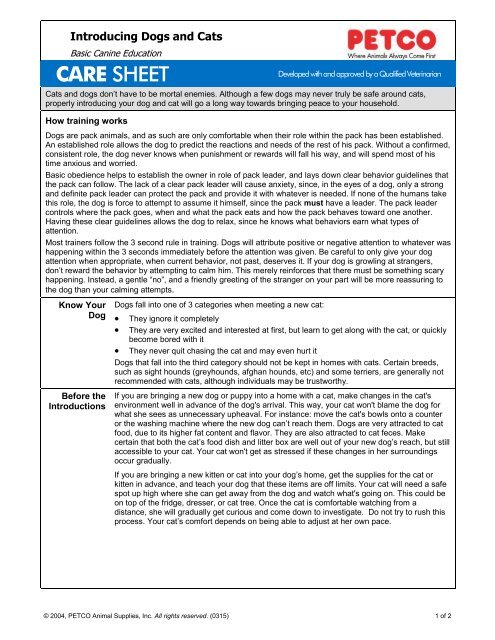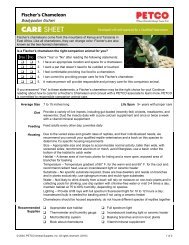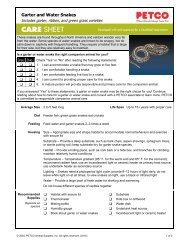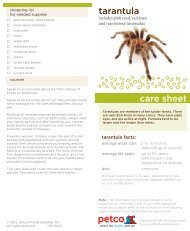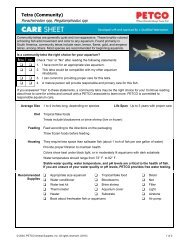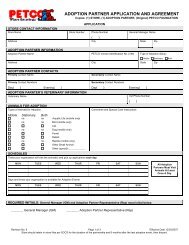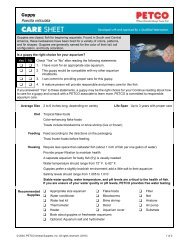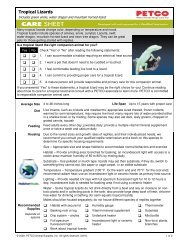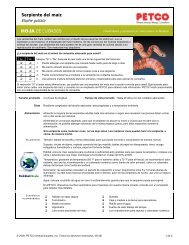CARE SHEET - Petco
CARE SHEET - Petco
CARE SHEET - Petco
Create successful ePaper yourself
Turn your PDF publications into a flip-book with our unique Google optimized e-Paper software.
Introducing Dogs and CatsBasic Canine Education<strong>CARE</strong> <strong>SHEET</strong>Developed with and approved by a Qualified VeterinarianCats and dogs don’t have to be mortal enemies. Although a few dogs may never truly be safe around cats,properly introducing your dog and cat will go a long way towards bringing peace to your household.How training worksDogs are pack animals, and as such are only comfortable when their role within the pack has been established.An established role allows the dog to predict the reactions and needs of the rest of his pack. Without a confirmed,consistent role, the dog never knows when punishment or rewards will fall his way, and will spend most of histime anxious and worried.Basic obedience helps to establish the owner in role of pack leader, and lays down clear behavior guidelines thatthe pack can follow. The lack of a clear pack leader will cause anxiety, since, in the eyes of a dog, only a strongand definite pack leader can protect the pack and provide it with whatever is needed. If none of the humans takethis role, the dog is force to attempt to assume it himself, since the pack must have a leader. The pack leadercontrols where the pack goes, when and what the pack eats and how the pack behaves toward one another.Having these clear guidelines allows the dog to relax, since he knows what behaviors earn what types ofattention.Most trainers follow the 3 second rule in training. Dogs will attribute positive or negative attention to whatever washappening within the 3 seconds immediately before the attention was given. Be careful to only give your dogattention when appropriate, when current behavior, not past, deserves it. If your dog is growling at strangers,don’t reward the behavior by attempting to calm him. This merely reinforces that there must be something scaryhappening. Instead, a gentle “no”, and a friendly greeting of the stranger on your part will be more reassuring tothe dog than your calming attempts.Know YourDogBefore theIntroductionsDogs fall into one of 3 categories when meeting a new cat:They ignore it completelyThey are very excited and interested at first, but learn to get along with the cat, or quicklybecome bored with itThey never quit chasing the cat and may even hurt itDogs that fall into the third category should not be kept in homes with cats. Certain breeds,such as sight hounds (greyhounds, afghan hounds, etc) and some terriers, are generally notrecommended with cats, although individuals may be trustworthy.If you are bringing a new dog or puppy into a home with a cat, make changes in the cat'senvironment well in advance of the dog's arrival. This way, your cat won't blame the dog forwhat she sees as unnecessary upheaval. For instance: move the cat's bowls onto a counteror the washing machine where the new dog can’t reach them. Dogs are very attracted to catfood, due to its higher fat content and flavor. They are also attracted to cat feces. Makecertain that both the cat’s food dish and litter box are well out of your new dog’s reach, but stillaccessible to your cat. Your cat won't get as stressed if these changes in her surroundingsoccur gradually.If you are bringing a new kitten or cat into your dog’s home, get the supplies for the cat orkitten in advance, and teach your dog that these items are off limits. Your cat will need a safespot up high where she can get away from the dog and watch what's going on. This could beon top of the fridge, dresser, or cat tree. Once the cat is comfortable watching from adistance, she will gradually get curious and come down to investigate. Do not try to rush thisprocess. Your cat’s comfort depends on being able to adjust at her own pace.© 2004, PETCO Animal Supplies, Inc. All rights reserved. (0315) 1 of 2
Introducing Dogs and CatsBasic Canine Education<strong>CARE</strong> <strong>SHEET</strong>TheHomecomingDeveloped with and approved by a Qualified VeterinarianWhen you first bring your new dog or cat home, confine her to a private room with the doorshut. Let the old and new pets sniff each other under the door. Do not allow the dog to dig atthe door, or to stand and bark constantly. If the dog will not stop, this may not be a goodcandidate for a cat-owning household.Place towels or beds that smell like the cat in the dog’s area, and vice versa. When the dog isoutside, allow the cat to roam the dog’s area, investigating the dog’s scent. Return the cat toher area before the dog comes back in. Then the dog will be able to smell the scent the catleft in his area.TheIntroductionAfter a day or so, place a leash on the dog, and open the door between the cat and dog.Allow the cat to come out on her own schedule. Don't force the introductions. Keep your dogleashed and tied at your side or in a wire crate where he can watch your cat, but not get toher. He may get real excited, and this step may take a few days, but gradually Kitty will getcloser and Rover will get used to her being around.Keep your dog on a leash in the house at all times so he won't chase your cat. If your dogcan't chase her, then your cat doesn't need to run. Once the running and chasing begin, it's ahard habit to break. It is just too much fun for the dog! Your cat won't need to run if she feelssafe.Distract an excited dog with treats and toys or a trip outside until he calms down. You canalso ask him to comply with some obedience commands to get his focus off the cat and ontoyou. If he lunges towards the cat, hold tight to the leash and correct him with a loud "LEAVEIT!" or "NO KITTY!" You don't have to be mad, just sound firm and in control. This is not arequest. It is a command. You are the pack leader who makes the rules, and he is expectedto listen. Reward him profusely when he returns his attention back to you, even if only for aninstant.Your dog learns by your tone of voice and the consequences he experiences. Bother the cat,he gets corrected; turn to you, he gets praise, happy talk and fun. Go way overboard with thepraise at first, so it's absolutely clear to your dog what you want.Never let your dog loose with your cat unless your cat has quit running off, and your dogshows no interest in chasing. Gradually the two will get used to each other, and you can relaxthe rules a bit. They may never be best friends, but they can learn to tolerate each otherpolitely. Who knows, they may both be sleeping on your bed soon!SuggestedReadingDogs for Dummies by Gina SpadaforiCats for Dummies By Gina Spadafori and Paul P. Dion, D.V.M.How To Get Your Dog To Do What You Want by Warren EcksteinHow to Get Your Cat to Do What You Want by Warren Eckstein2 of 2 SKU 945099 © 2004, PETCO Animal Supplies, Inc. All rights reserved. (0315)


